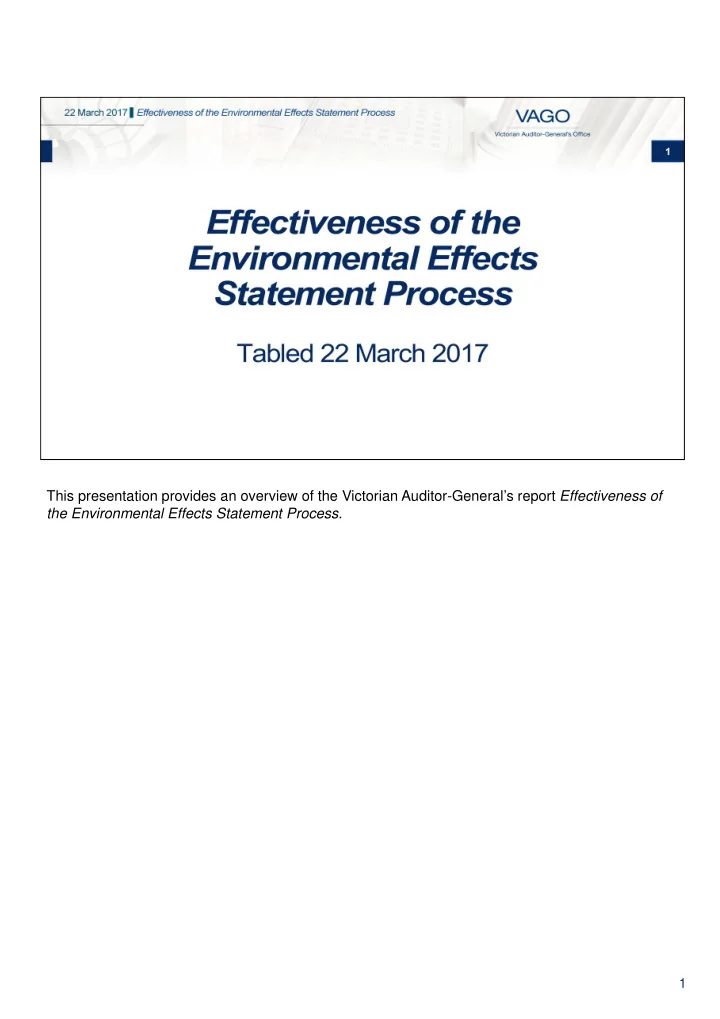

This presentation provides an overview of the Victorian Auditor-General’s report Effectiveness of the Environmental Effects Statement Process. 1
Land use planning and development are important for meeting the changing needs of the growing Victorian population. The effects of development on the environment are critical considerations in planning and development. An environmental impact assessment is a tool used to predict the environmental, social and economic effects of a proposed development at an early stage in project planning and design. The assessment aims to find ways to reduce negative impacts, and to shape projects to suit the local environment. 2
In Victoria, for projects likely to have a significant environmental impact, the Environmental Effects Statement (EES) process is the main statutory mechanism for assessing environmental effects at the state or regional level. The Minister for Planning administers the EES process under the Environmental Effects Act 1978 (EE Act). 3
In this audit, we examined whether the Department of Environment, Land, Water and Planning (the department) is effectively managing the EES process. 4
The minister’s assessment of the environmental effects of a project is provided to inform decision- making, but under the EE Act, statutory decision-makers are not bound by the minister’s recommendations. Since 2000, two reviews and a parliamentary inquiry have found the legislation and associated EES processes to be costly, and lacking clarity and transparency. Between 2000 and 2013, successive governments committed to reforming the EES process, yet no significant legislative changes have occurred. This has constrained the department’s ability to improve outcomes. 5
The department has focused on administrative improvement to its internal processes through the introduction of a quality management system. When the minister sets conditions for a project in lieu of preparing an EES, the department oversees compliance with these conditions. We found that the department has not established a risk-based system to monitor and document compliance with any conditions imposed. While statutory decision-makers are not bound by the recommendations in the minister’s assessment, we found that the department does not have a process for these decision-makers to report their response to the recommendations. 6
There is no statutory requirement to refer development projects when they may potentially have a significant effect on the environment. Despite this, the department has not established a robust process for identifying projects for referral. As a consequence, it relies on its networks to inform it of upcoming projects that should be referred. There is a risk that the department may miss projects that should be referred, or might identify them too late to activate the EES process. 7
The EE Act authorises the minister to set conditions for a development project in lieu of requiring an EES. If the proponent does not comply with these conditions, the minister has the legislative authority to ask the proponent to prepare an EES. Although the department oversees the implementation of conditions set in lieu of an EES, it does not have a comprehensive system for monitoring and reporting on these conditions. 8
A technical reference group (TRG) is appointed for each project subject to the EES process. The TRG provides advice to the proponent and the department during the scoping and preparation of the EES. The proponent consultants we interviewed reported that when TRG members did not have the necessary knowledge, experience or authority, the TRG could not perform its role to its optimal capacity. 9
During the EES process, the department manages public consultation process and advises the minister. All projects we examined conducted the public review through an 'inquiry by formal hearing'. All proponents in these projects had legal representation. For those with no legal representation, this can create a perception of disadvantage. The department does not outline its reasoning for recommending inquiry by formal hearing over other inquiry options. 10
We made eight recommendations to the department to: • review its position on whether legislative review and further reform is required • systemically review its internal guidance and update as required • develop and implement a risk-based system for monitoring compliance with conditions in lieu of an EES • develop a process for statutory decision-makers to report their response to the minister’s recommendations • publish a guide on the inputs and detail required from proponents in the scoping phase • develop balanced scoping requirements for each EES • establish a process for securing TRG members with appropriate expertise, and • outline reasoning behind advice to the minister on inquiry options. The department has accepted the recommendations. 11
For further information, please see the full report of this audit on our website, www.audit.vic.gov.au. 12
Recommend
More recommend